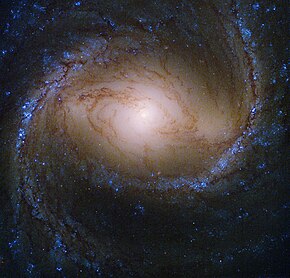| Messier 91 | |
|---|---|
 Spiral Galaxy Messier 91 | |
| Observation data (J2000 epoch) | |
| Constellation | Coma Berenices |
| Right ascension | 12h 35m 26.4s[1] |
| Declination | +14° 29′ 47″[1] |
| Redshift | 486 ± 4 km/s[1] |
| Distance | 63 ± 16 Mly (19 ± 5 Mpc)[2] |
| Apparent magnitude (V) | 10.2[3] |
| Characteristics | |
| Type | SBb(rs)[1] |
| Apparent size (V) | 5.4′ × 4.3′[1] |
| Other designations | |
| NGC 4548,[1] UGC 7753,[1] PGC 41934[1] | |
Messier 91 (also known as NGC 4548 or M91)[4][5] is a barred spiral galaxy that is found in the south of Coma Berenices. It is in the local supercluster and is part of the Virgo Cluster of galaxies. It is about 63 million light-years away from our galaxy. It was the last of a group of eight "nebulae" – the term 'galaxy' only coming into use for these objects once it was realized in the 20th century that they were extragalactic – discovered by Charles Messier in 1781. It is the faintest object in the Messier catalog, with an apparent magnitude of 10.2.[3]
As a result of a bookkeeping error by Messier, M91 was for a long time one of the few missing entries in the Messier catalog, not matching any known object in the sky. It was not until 1969 that amateur astronomer William C. Williams[4] realized that M91 was NGC 4548,[5] which was catalogued by William Herschel in 1784. Some sources contend the nearby spiral galaxy NGC 4571 was considered as a candidate for this object by Herschel.[5]
- ^ a b c d e f g h "NASA/IPAC Extragalactic Database". Results for NGC 4548. Retrieved 2006-12-13.
- ^ J. L. Tonry; A. Dressler; J. P. Blakeslee; E. A. Ajhar; et al. (2001). "The SBF Survey of Galaxy Distances. IV. SBF Magnitudes, Colors, and Distance". Astrophysical Journal. 546 (2): 681–693. arXiv:astro-ph/0011223. Bibcode:2001ApJ...546..681T. doi:10.1086/318301. S2CID 17628238.
- ^ a b "Messier 91". SEDS Messier Catalog. Retrieved 30 April 2022.
- ^ a b William C. Williams Letter, Sky and Telescope, December 1969, p. 376. Accessed 13 April 2011
- ^ a b c Students for the Exploration and Development of Space Messier 91, Accessed online 14 April 2011